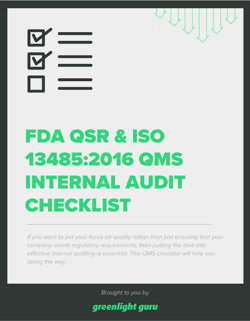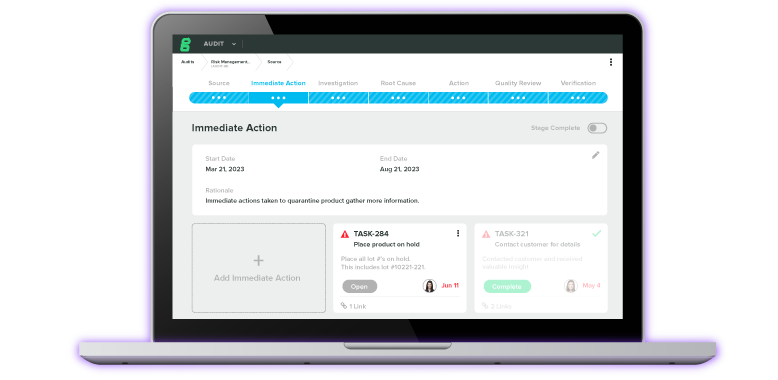.png)
Over the past several years, FDA has been more aggressive and active in performing medical device company inspections.This has lead to a far greater number of companies receiving form 483s and FDA warning letters.
483's are a good way for your medical device company to flush $400,000 down the drain.
FDA could call tomorrow to announce their plans to visit your facility next week.Has it been a few years since your last inspection? You know an FDA inspection will happen.
Would you be prepared?
What do you need to do to get ready?
While I do not have all the answers, I have been through more than a few FDA inspections.
Previously we've shared 3 surefire way to ensure you get an FDA 483 observation, but today I'd like to share with you 5 tips and pointers to help your medical device company get prepared for an FDA inspection.
#1: Your Quality System Will Be Reviewed During an FDA Inspection
FDA Quality System Regulations as defined in 21 CFR part 820 are required for medical device companies in the U.S.
This means you need to have established, documented procedures, forms, work instructions, etc. implemented and in use to demonstrate compliance with FDA Quality System Regulations.
Drafting procedures to comply with FDA regulations is one thing.
Making sure your procedures align with the company’s practices is another.
During an FDA inspection, both the procedures and your actual practices will be reviewed and audited.
#2: Use Internal Quality Audits To Your Advantage
A great tool to help you fine-tune your Quality System procedures are quality audits.
Quality audits include internal auditing and external audits, whether by FDA or other entities.
Preforming internal quality audits may be a little scary at first, especially if your processes are newly established.
But embrace the benefits internal auditing provides your medical device company.
Internal auditing is a great way to identify areas of concern and potential compliance issues.
You want your internal auditing program to be much tougher than the audit you will experience during an FDA inspection.
Use the internal audits as a springboard to continuous improvement.
Important aspects of a robust quality auditing program includes both individual process audits as well as quality system overview audits.
A great technique to follow is “QSIT” or Quality System Inspection Techniques.
Why is this a good technique?
Because FDA will use a QSIT-style approach during your FDA inspection.
The QSIT approach identifies a Quality System based on major subsystems:

FDA has well defined checklists and a guidance for QSIT.
Use this to your advantage.
#3: Being ISO 13485 Certified Is Somewhat Irrelevant
Many medical devices pursue and obtain ISO 13485 certification, especially if you have interest in any markets outside the U.S.
However, being ISO certified does not ensure you meet FDA QSRs.
There is a good chance you have been through a couple ISO audits and given the impression your Quality System is in decent shape.
From FDA's perspective, this can be misleading.
FDA is concerned that you meet 21 CFR part 820.
ISO 13485 certification is irrelevant during an FDA inspection.
ISO 13485 pertains to European Medical Device Directives.
21 CFR part 820 is FDA law.
Just keep this in mind.
But also realize that having one Quality System to meet the requirements of ISO 13485 and FDA 21 CFR part 820 is definitely possible (and recommended).
#4: Prep Your Team for the Inspection
Aside from focusing on the Quality System aspects in preparation for an FDA inspection, you should also be sure to prep your employees, team members, and so on.
No one looks forward to an FDA inspection.
And usually when the term “FDA” is brought up in the medical device industry, many suddenly start to fear the worse.
As long as you are informed and prepared, you should not fear an FDA inspection.
Yes, regardless of how prepped you and your team are, the FDA inspection will be tense and stressful.
Your preparations should incorporate mock FDA inspections.
You should use this as an opportunity to coach employees on what to say and how to interact.
Seek out training and others who have been through an FDA inspection before. Ask these resources to assess your preparedness and readiness.
This upfront preparation is just as important as anything else you can do to get ready for an FDA inspection.
Knowing what to expect before it happens is helpful and will reduce the anxiety.
Your preparation should go through every aspect of what could happen during an FDA inspection.
From the moment an FDA inspector walks through the door, to where to hold the inspection, to the staff (and back-ups) needed during an FDA inspection.
Define roles and responsibilities before FDA shows up.
Your team should also be coached on responding to questions during a FDA inspection.
If the inspector asks a question, provide the specific response to the question, nothing more.
I’ll give you an example:
- FDA Inspector: “Do you have a complaint procedure?”
- Your response: “Yes.”
It’s a little bit of a “dance,” but I encourage you to only answer directly what was asks.
#5: It's Showtime Once the FDA Inspector Arrives
While FDA will more than likely call before an FDA inspection, they do not have to.
FDA could show up tomorrow.
Once you receive notice of an FDA inspection (and hopefully it’s a call ahead of time), it’s time to put the plan to action.
You will be frantic. You will panic, at least a little. That's okay, and to some degree, is expected.
If you stay prepared, then you are ready for FDA anytime. Conduct business as normal.
You will want to make sure every complaint investigation is completed, all CAPAs are closed, and so on. But you should not suddenly change your business practices just because of a pending FDA inspection.
Don’t feel like every open CAPA, change order, and complaint file needs to be completed and closed.
If after doing everything you can internally to prepare, you still feel you are not ready to lead an FDA inspection, that’s okay. But don’t dive in alone and hope you can survive.
It’s perfectly okay to bring in an outside resource to be the face of your company during an FDA inspection. I’ve served this role many times.
Once the FDA inspector arrives, it’s showtime.
Discreetly let everyone in your company know.
Greet the inspector and escort him / her to your designated room you've set up in advance. The inspector will give you a Form 482 Notice of Inspection.
The inspector will also provide his / her credential, including a badge (yes, they are a federal agent).
Chances are the FDA inspector will ask for a tour of your facility near the beginning of the inspection.
Have someone from your company with the FDA inspector at all times. Okay, if he / she needs to use the restroom, you don’t need to go into the stall. But do wait patiently by the door.
After the tour, the FDA inspector will dive right in. Don’t feel the need to make small talk. Although the silence can often times be very awkward.
As the FDA inspection progresses, the inspector will find issues which you will need to correct.
Do not feel obligated to fix the issues during the inspection. You don’t get extra points for doing so. In fact, FDA discourages this practice.
If the FDA inspector has a question or makes an observation that you do not understand, ask for clarification and an explanation.
It’s better you understand what the issue is during an FDA inspection rather than guess days after.
The FDA inspector may have observations that you do not agree with.
Do your best to state your case with supporting objective evidence.
But DO NOT be argumentative. Make your case, understand the comments, and move on.
FDA makes the rules. FDA interprets the rules. You need to comply with the rules.
Always answer questions truthfully. Don’t try to answer based on what you think the FDA inspector wants to hear.
Remember that your responses should be supported by documentation and records.
If you do not know the answer, it is better to say, “I don’t know” than to make up a response.
Jon Speer is a medical device expert with over 20 years of industry experience. Jon knows the best medical device companies in the world use quality as an accelerator. That's why he created Greenlight Guru to help companies move beyond compliance to True Quality.
Related Posts
7 Steps to Respond to FDA 483 Inspection Observations (Response Template Included)
FDA QSIT: Preparing Your Medical Device Company for an Inspection
Standard Conformity or Regulatory Compliance? Distinguishing the Two
Get your free resource
Internal Audit Checklist









